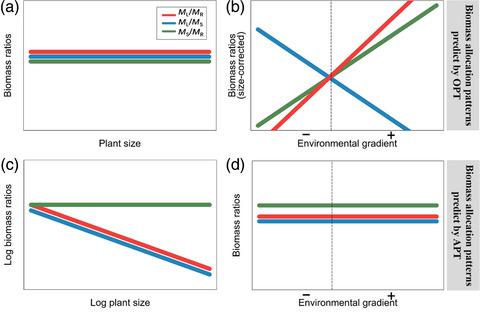Our official English website, www.x-mol.net, welcomes your
feedback! (Note: you will need to create a separate account there.)
Allometry rather than abiotic drivers explains biomass allocation among leaves, stems and roots of Artemisia across a large environmental gradient in China
Journal of Ecology ( IF 5.3 ) Pub Date : 2020-10-24 , DOI: 10.1111/1365-2745.13532 Rong Liu 1, 2 , Xuejun Yang 1 , Ruiru Gao 3 , Xinyu Hou 3 , Liping Huo 3 , Zhenying Huang 1 , Johannes H. C. Cornelissen 4
更新日期:2020-10-24
Journal of Ecology ( IF 5.3 ) Pub Date : 2020-10-24 , DOI: 10.1111/1365-2745.13532 Rong Liu 1, 2 , Xuejun Yang 1 , Ruiru Gao 3 , Xinyu Hou 3 , Liping Huo 3 , Zhenying Huang 1 , Johannes H. C. Cornelissen 4
Affiliation

|
- Biomass allocation patterns reflect the adaptive strategies of plants growing in different environments, which is a central issue in comparative plant ecology and evolution. However, the factors underpinning specific allocation patterns across organs and the existence of general rules governing allocation remain contentious. Optimal partitioning theory (OPT) states that plants can respond to resource availability by allocating relatively more biomass to the organ that captures the most limiting resources to optimize growth. In contrast, allometric partitioning theory (APT) postulates that biomass allocation among organs is a power function of plant size independently of environmental variation. As phylogenetic and growth form constraints (e.g. formation of inert heartwood in tree clades) may also affect biomass allocation, comparison among and within closely related taxa of rather similar growth form may enable a more direct testing of which of these two theories prevails.
- To test whether OPT or APT was prevalent at wide geographical scale, we investigated biomass allocation patterns among leaves, stems and roots of 1,022 plants of 62 Artemisia species (Asteraceae) collected along broad climate (annual mean temperature range: −4.9 to 18.0°C, annual mean precipitation range: 193–1,668 mm) and soil gradients (soil carbon content range: 1.6–15.4 kg C m−2) in central and eastern China.
- There were strong allometric relationships among leaf mass (ML), stem mass (MS) and root mass (MR) at both interspecific and intraspecific levels. Moreover, the interspecific and intraspecific patterns were not different from general patterns for pooled plants, that is, ML/MR and ML/MS, but not MS/MR, generally decreased with plant size. However, the three organ mass ratios were not responsive to broad climatic or soil gradients after the effect of plant size was removed.
- Synthesis. Our results generally support APT instead of OPT, suggesting that Artemisia plants have evolved an allometric strategy rather than relying on adjustment of allocation among organs to adapt to the broadly varying environments at the regional scale. For follow‐up research, we hypothesize that the strong allometric constraints on biomass allocation should depend on strong physiological adaptive responses of the different organs of Artemisia to environmental gradients.











































 京公网安备 11010802027423号
京公网安备 11010802027423号